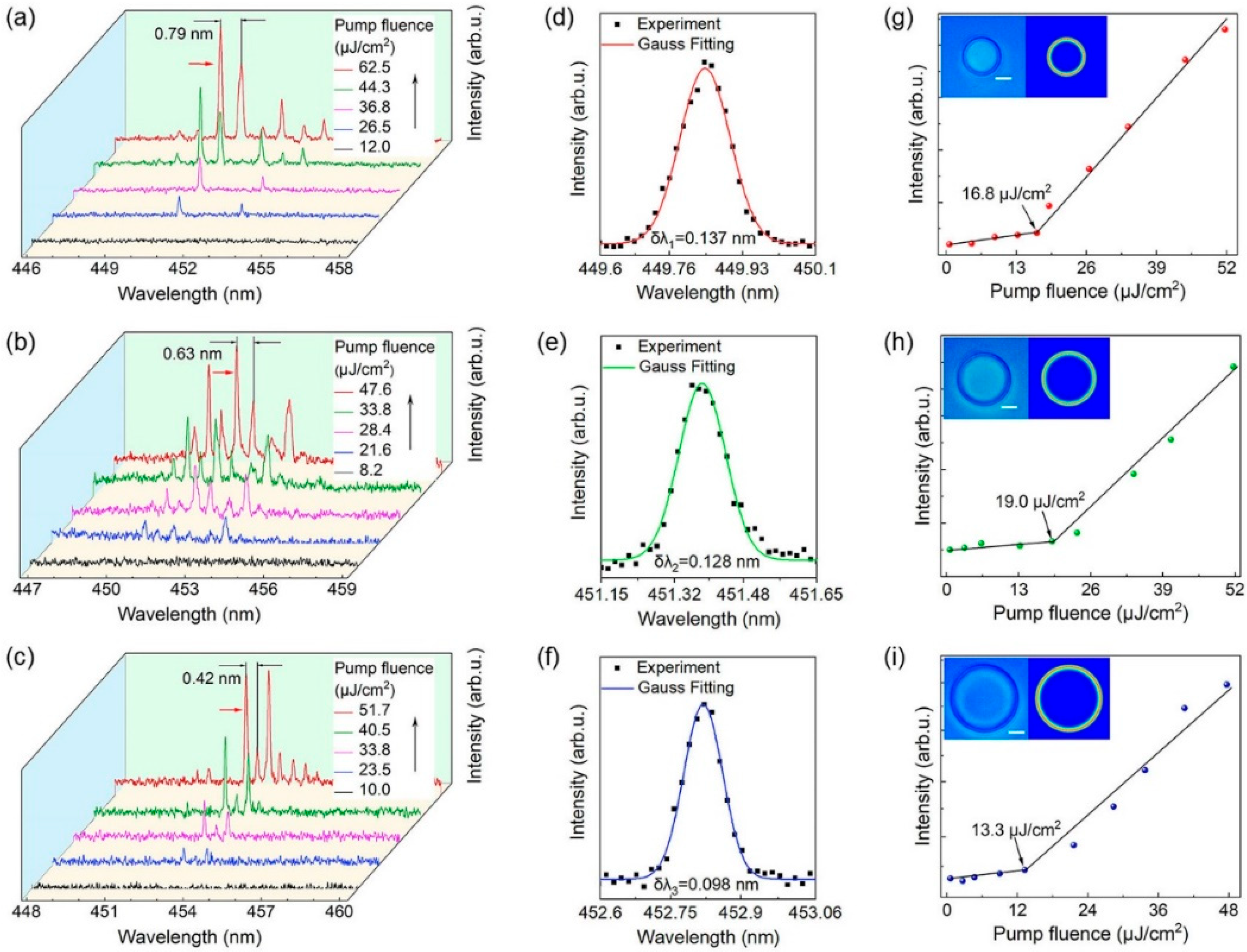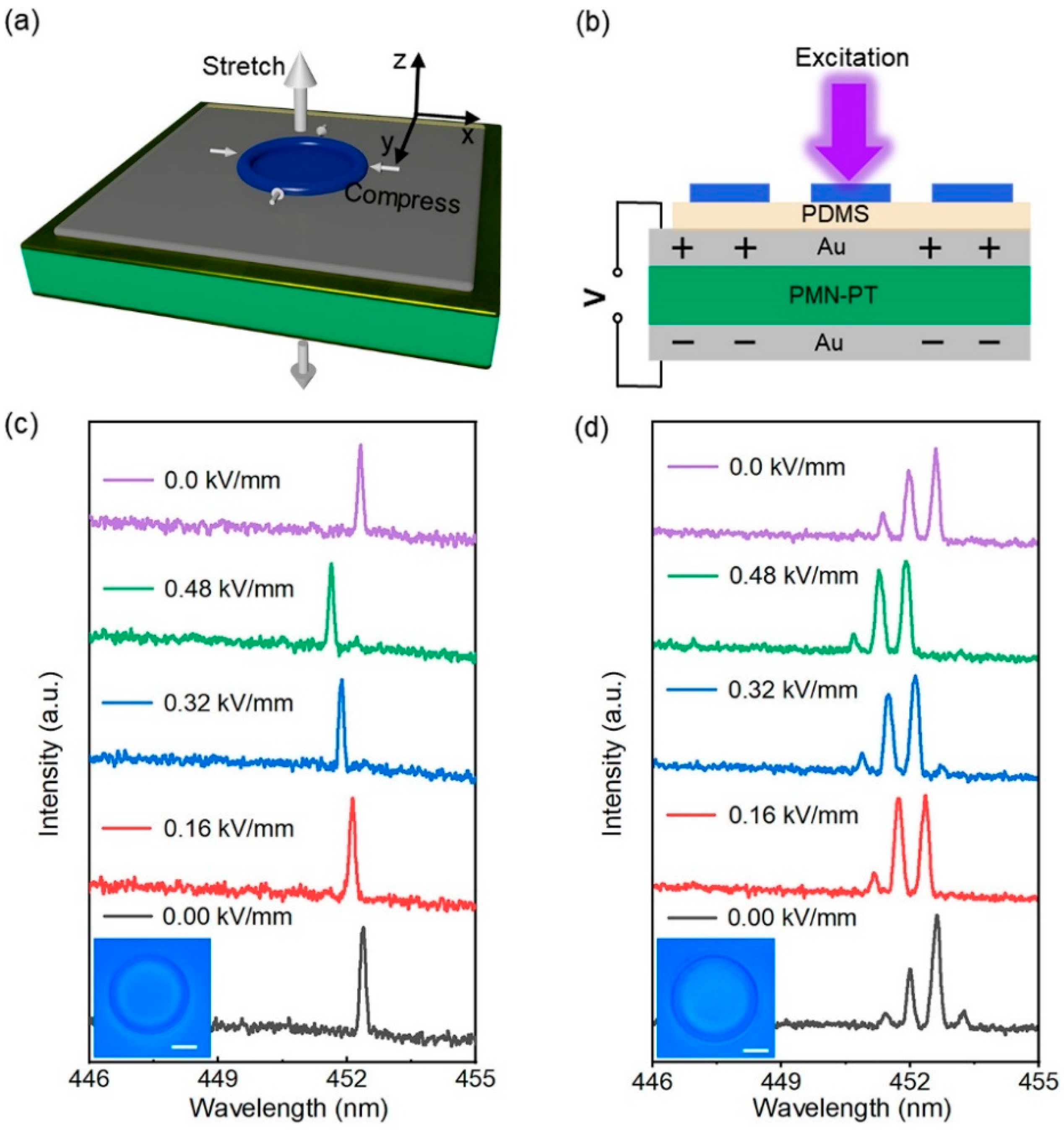Electrically Tunable Polymer Whispering-Gallery-Mode Laser
Abstract
:1. Introduction
2. Fabrication and Measurement
3. Results and Discussions
3.1. Emission Spectra
3.2. Wavelength Tuning
4. Conclusions
Author Contributions
Funding
Institutional Review Board Statement
Informed Consent Statement
Data Availability Statement
Conflicts of Interest
References
- Hill, M.T.; Gather, M.C. Advances in Small Lasers. Nat. Photonics 2014, 8, 908–918. [Google Scholar] [CrossRef] [Green Version]
- Ma, R.-M.; Oulton, R.F. Applications of nanolasers. Nat. Nanotechnol. 2019, 14, 12–22. [Google Scholar] [CrossRef] [PubMed]
- Yang, L.; Armani, D.K.; Vahala, K.J. Fiber-coupled erbium microlasers on a chip. Appl. Phys. Lett. 2003, 83, 825–826. [Google Scholar] [CrossRef] [Green Version]
- Gao, R.; Guan, J.; Yao, N.; Deng, L.; Wang, Z.; Cheng, Y. On-chip ultra-narrow-linewidth single-mode microlaser on lithium niobate on insulator. Opt. Lett. 2021, 46, 3131–3134. [Google Scholar] [CrossRef] [PubMed]
- Liao, J.; Yang, L. Optical whispering-gallery mode barcodes for high-precision and wide-range temperature measurements. Light. Sci. Appl. 2021, 10, 1–11. [Google Scholar] [CrossRef] [PubMed]
- Guo, X.; Zhen, S.; Ouyang, T.; Zhou, S.; Pan, Q.; Yang, D.; Tang, B.Z. An organic microlaser based on an aggregation-induced emission fluorophore for tensile strain sensing. J. Mater. Chem. C 2021, 9, 4888–4894. [Google Scholar] [CrossRef]
- Lu, Q.; Chen, X.; Fu, L.; Xie, S.; Wu, X. On-Chip Real-Time Chemical Sensors Based on Water-Immersion-Objective Pumped Whispering-Gallery-Mode Microdisk Laser. Nanomaterials 2019, 9, 479. [Google Scholar] [CrossRef] [Green Version]
- Kushida, S.; Okada, D.; Sasaki, F.; Lin, Z.H.; Huang, J.S.; Yamamoto, Y. Low-Threshold Whispering Gallery Mode Lasing from Self-Assembled Microspheres of Single-Sort Conjugated Polymers. Adv. Opt. Mater. 2017, 5, 1700123. [Google Scholar] [CrossRef]
- Mai, H.H.; Nguyen, T.T.; Giang, K.M.; Do, X.T.; Nguyen, T.T.; Ta, V.D. Chicken albumen-based whispering gallery mode microlasers. Soft Matter 2020, 16, 9069–9073. [Google Scholar] [CrossRef]
- Wang, Z.; Fang, Z.; Liu, Z.; Chu, W.; Zhou, Y.; Zhang, J.; Cheng, Y. On-chip tunable microdisk laser fabricated on Er 3+-doped lithium niobate on insulator. Opt. Lett. 2021, 46, 380–383. [Google Scholar] [CrossRef]
- Gil-Santos, E.; Ruz, J.J.; Malvar, O.; Favero, I.; Lemaître, A.; Tamayo, J. Optomechanical detection of vibration modes of a single bacterium. Nat. Nanotechnol. 2020, 15, 469–474. [Google Scholar] [CrossRef] [PubMed]
- Xu, L.; Jiang, X.; Zhao, G.; Ma, D.; Tao, H.; Liu, Z.; Yang, L. High-Q silk fibroin whispering gallery microresonator. Opt. Express 2016, 24, 20825–20830. [Google Scholar] [CrossRef] [PubMed] [Green Version]
- Rosenblum, S.; Lovsky, Y.; Arazi, L.; Vollmer, F.; Dayan, B. Cavity ring-up spectroscopy for ultrafast sensing with optical microresonators. Nat. Commun. 2015, 6, 1–5. [Google Scholar] [CrossRef]
- Yin, Y.; Niu, Y.; Ren, M.; Wu, W.; Zhao, W.; Nan, J.; Ding, M. Strain sensing based on a microbottle resonator with cleaned-up spectrum. Opt. Lett. 2018, 43, 4715–4718. [Google Scholar] [CrossRef] [PubMed]
- He, C.; Sun, H.; Mo, J.; Yang, C.; Feng, G.; Zhou, H.; Zhou, S. Temperature sensor based on high-Q polymethylmethacrylate optical microbubble. Laser Phys. 2018, 28, 076202. [Google Scholar] [CrossRef]
- Hogan, L.T.; Horak, E.H.; Ward, J.M.; Knapper, K.A.; Nic Chormaic, S.; Goldsmith, R.H. Toward real-time monitoring and control of single nanoparticle properties with a microbubble resonator spectrometer. ACS Nano 2019, 13, 12743–12757. [Google Scholar] [CrossRef]
- Tang, S.J.; Liu, Z.; Qian, Y.J.; Shi, K.; Sun, Y.; Wu, C.; Xiao, Y.F. A tunable optofluidic microlaser in a photostable conjugated polymer. Adv. Mater. 2018, 30, 1804556. [Google Scholar] [CrossRef]
- Ge, K.; Zhai, T.; Xu, Z.; Guo, D.; Niu, B.; Ruan, J.; Cui, L. RGB WGM lasing woven in fiber braiding cavity. Sci. China inf. Sci. 2022. [Google Scholar] [CrossRef]
- Zhang, M.; Wang, C.; Cheng, R.; Shams-Ansari, A.; Lončar, M. Monolithic ultra-high-Q lithium niobate microring resonator. Optica 2017, 4, 1536–1537. [Google Scholar] [CrossRef]
- Du, W.; Zhang, S.; Wu, Z.; SMi, Y.; Chen, J.; Liu, X. Unveiling lasing mechanism in CsPbBr3 microsphere cavities. Nanoscale 2019, 11, 3145–3153. [Google Scholar] [CrossRef]
- Zhang, S.; Shi, X.; Yan, S.; Zhang, X.; Ge, K.; Han, C.; Zhai, T. Single-mode lasing in plasmonic-enhanced woven microfibers for multifunctional sensing. ACS Sensors 2021, 6, 3416–3423. [Google Scholar] [CrossRef] [PubMed]
- Xu, Z.; Zhai, T.; Shi, X.; Tong, J.; Wang, X.; Deng, J. Multifunctional Sensing Based on an Ultrathin Transferrable Microring Laser. ACS Appl. Mater. Inter. 2021, 13, 19324–19331. [Google Scholar] [CrossRef] [PubMed]
- Ta, D.; Saxena, D.; Caixeiro, S.; Sapienza, R. Flexible and tensile microporous polymer fibers for wavelength-tunable random lasing. Nanoscale 2020, 12, 12357–12363. [Google Scholar] [CrossRef] [PubMed]
- Wang, Y.; Li, H.; Zhao, L.; Liu, Y.; Liu, S.; Yang, J. Tunable whispering gallery modes lasing in dye-doped cholesteric liquid crystal microdroplets. Appl. Phys. Lett. 2016, 109, 231906. [Google Scholar] [CrossRef]
- Zhu, S.; Shi, L.; Xiao, B.; Zhang, X.; Fan, X. All-optical tunable microlaser based on an ultrahigh-Q erbium-doped hybrid microbottle cavity. ACS Photonics 2018, 5, 3794–3800. [Google Scholar] [CrossRef]
- Huang, H.; Yu, Z.; Zhou, D.; Li, S.; Fu, L.; Wu, Y.; Fu, H. Wavelength-Turnable organic microring laser arrays from thermally activated delayed fluorescent emitters. ACS Photonics 2019, 6, 3208–3214. [Google Scholar] [CrossRef]
- Zhuge, M.H.; Yang, Z.; Zhang, J.; Zheng, Y.; Song, Q.; Pang, C.; Hasan, T. Fiber-integrated reversibly wavelength-tunable nanowire laser based on nanocavity mode coupling. ACS Nano 2019, 13, 9965–9972. [Google Scholar] [CrossRef]
- Du, Y.; Zou, C.L.; Zhang, C.; Wang, K.; Qiao, C.; Yao, J.; Zhao, Y.S. Tuneable red, green, and blue single-mode lasing in heterogeneously coupled organic spherical microcavities. Light Sci. Appl. 2020, 9, 1–9. [Google Scholar] [CrossRef]
- Ge, K.; Guo, D.; Niu, B.; Xu, Z.; Ruan, J.; Zhai, T. Pump-controlled RGB single-mode polymer lasers based on a hybrid 2D–3D μ-cavity for temperature sensing. Nanophotonics 2021, 10, 4591–4599. [Google Scholar] [CrossRef]
- Ta, V.D.; Chen, R.; Sun, H.D. Tuning whispering gallery mode lasing from self-assembled polymer droplets. Sci. Rep. 2013, 3, 1–5. [Google Scholar] [CrossRef]
- Chen, R.; Ta, V.D.; Sun, H.D. Bending-induced bidirectional tuning of whispering gallery mode lasing from flexible polymer fibers. ACS Photonics 2014, 1, 11–16. [Google Scholar] [CrossRef]
- Wei, Y.; Dong, H.; Wei, C.; Zhang, W.; Yan, Y.; Zhao, Y.S. Wavelength-Tunable Microlasers Based on the Encapsulation of Organic Dye in Metal–Organic Frameworks. Adv. Mater. 2016, 28, 7424–7429. [Google Scholar] [CrossRef] [PubMed]
- Dong, H.; Wei, Y.; Zhang, W.; Wei, C.; Zhang, C.; Yao, J.; Zhao, Y.S. Broadband tunable microlasers based on controlled intramolecular charge-transfer process in organic supramolecular microcrystals. J. Am. Chem. Soc. 2016, 138, 1118–1121. [Google Scholar] [CrossRef] [PubMed]
- Guo, Z.; Wang, H.; Zhao, C.; Lin, C.; Liu, S.; Hu, J. Spectral Modulation of Optofluidic Coupled-Microdisk Lasers in Aqueous Media. Nanomaterials 2019, 9, 1439. [Google Scholar] [CrossRef] [PubMed] [Green Version]
- Döring, S.; Kollosche, M.; Rabe, T.; Stumpe, J.; Kofod, G. Electrically tunable polymer DFB laser. Adv. Mater. 2011, 23, 4265–4269. [Google Scholar] [CrossRef]
- Dhoore, S.; Köninger, A.; Meyer, R.; Roelkens, G.; Morthier, G. Electronically tunable distributed feedback (DFB) laser on silicon. Laser Photonics Rev. 2019, 13, 1800287. [Google Scholar] [CrossRef]
- Yang, C.; Zhang, H.; Liu, B.; Liu, H.; Wang, C.; Lin, S. Electrically tuned whispering gallery modes microresonator based on microstructured optical fibers infiltrated with dual-frequency liquid crystals. Nanophotonics 2018, 7, 1333–1340. [Google Scholar]
- Ge, K.; Niu, B.; Liu, F.; Ruan, J.; Xu, Z.; Guo, D.; Wang, X.; Lv, L.; Zhai, T. Electrically tunable WGM lasing in a metal-dielectric core–shell hybrid microcavity. Appl. Phys. Lett. 2022, 120, 232201. [Google Scholar]
- Deegan, R.D.; Bakajin, O.; Dupont, T.F.; Huber, G.; Nagel, S.R.; Witten, T.A. Capillary flow as the cause of ring stains from dried liquid drops. Nature 1997, 389, 827–829. [Google Scholar] [CrossRef]
- Zhang, C.; Zou, C.L.; Zhao, Y.; Dong, C.H.; Wei, C.; Wang, H.; Zhao, Y.S. Organic printed photonics: From microring lasers to integrated circuits. Sci. Adv. 2015, 1, e1500257. [Google Scholar] [CrossRef] [Green Version]
- Zhang, X.; Hu, Q.; Lin, J.; Lin, Z.; Guo, X.; Xie, L.; Lai, W.; Huang, W. Efficient and stable deep blue polymer light-emitting devices based on β-phasepoly(9,9-dioctylfluorene). Appl Phys Lett. 2013, 103, 153301. [Google Scholar]
- Lu, H.H.; Liu, C.Y.; Chang, C.H.; Chen, S.A. Self-Dopant Formation in Poly (9, 9-di-n-octylfluorene) Via a Dipping Method for Efficient and Stable Pure-Blue Electroluminescence. Adv Mater. 2007, 19, 2574–2579. [Google Scholar]
- Yang, S.; Wang, Y.; Sun, H.D. Advances and prospects for whispering gallery mode microcavities. Adv. Opt. Mater. 2015, 3, 1136–1162. [Google Scholar] [CrossRef]
- Bhowmik, A.K. Polygonal Optical Cavities. Appl. Opt. 2000, 39, 3071–3075. [Google Scholar] [CrossRef] [PubMed]
- Wang, F.; Liu, D.; Chen, Z.; Duan, Z.; Zhang, Y.; Sun, D.; Luo, H. In situ reversible tuning of photoluminescence of an epitaxial thin film via piezoelectric strain induced by a Pb (Mg1/3 Nb2/3) O3–PbTiO3 single crystal. J. Mater. Chem. C 2017, 5, 9115–9120. [Google Scholar] [CrossRef]




Publisher’s Note: MDPI stays neutral with regard to jurisdictional claims in published maps and institutional affiliations. |
© 2022 by the authors. Licensee MDPI, Basel, Switzerland. This article is an open access article distributed under the terms and conditions of the Creative Commons Attribution (CC BY) license (https://creativecommons.org/licenses/by/4.0/).
Share and Cite
Liu, F.; Tong, J.; Xu, Z.; Ge, K.; Ruan, J.; Cui, L.; Zhai, T. Electrically Tunable Polymer Whispering-Gallery-Mode Laser. Materials 2022, 15, 4812. https://doi.org/10.3390/ma15144812
Liu F, Tong J, Xu Z, Ge K, Ruan J, Cui L, Zhai T. Electrically Tunable Polymer Whispering-Gallery-Mode Laser. Materials. 2022; 15(14):4812. https://doi.org/10.3390/ma15144812
Chicago/Turabian StyleLiu, Fangyuan, Junhua Tong, Zhiyang Xu, Kun Ge, Jun Ruan, Libin Cui, and Tianrui Zhai. 2022. "Electrically Tunable Polymer Whispering-Gallery-Mode Laser" Materials 15, no. 14: 4812. https://doi.org/10.3390/ma15144812






